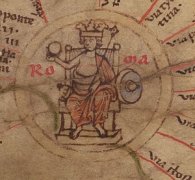DFG-project “Commentary on the Tabula Peutingeriana”
The Tabula Peutingeriana, which has been a UNESCO World Heritage since 2007, is an exceptional testimony of the history of cartography. The artifact still available to us is a representation of geographical knowledge and dates back to about 1200 AD while the last ancient edition dates back to the time around 435 AD. Due to the fact that it has been the only large-format map surviving from ancient times, it is crucial to analyze this exceptional relic in order to understand the spatial conception of ancient times. Even the peculiar format of the parchment-scroll is unique: with almost 6.80 meters in length and only 0.33 meters in width, the Tabula shows the inhabited world from the Iberian Peninsula (unfortunately, the first segment is not preserved anymore) to India in an extremely distorted way. We are thus able to conceive an ancient tradition of non-scale maps outside the highly elite mathematical geography, and can therefore make inferences about how broadly the geographical knowledge was received within the Roman aristocracy.
The DFG-project “Commentary on the Tabula Peutingeriana” addresses these controversies by focusing primarily on the following aspects: time and stages of origin, references to other maps and literal-geographical sources, design, geographical correctness and usability, purpose and addressed audience, as well as the amount of medieval modifications and possible copyist errors.
The roughly 3500 toponyms contained in the TP that have been commented on and analyzed are groundbreaking in many ways, including calling into question established theories regarding age determination, sources, and purpose. Assuming that there was an early Hellenistic predecessor to the TP, further consequences for the history of the ancient cartography should be derived, meaning that the Tabula has to be seen less as a result of Greek and Roman cartography, but more as an early artifact in the development of cartography. Furthermore, the focus is on the different stages of editing, knowing that it is difficult to determine its time of creation. In doing so, the TP has to be read as a work in progress, the purpose of which changed eventually with its transforming historical and cultural backgrounds. Based on recent spatial theories, the TP should be understood as cultural evidence that documents how this particular type of depiction of a geographical, as well as social, political, and religious space was used through the ages. Interpreting the TP as a repository of knowledge and a medium of memoria allows for drawing conclusions concerning methods, possibilities, and limitations in the general process of generating and passing on knowledge.
Creating this commentary is innovative in many respects. This is particularly applicable to the Western parts of Africa where only a few preliminary studies have been conducted so far. Further, concerning the Eastern parts of the Roman Empire, we can only refer to very few late 19th and early 20th century publications but unfortunately not to a comprehensive work of reference.

